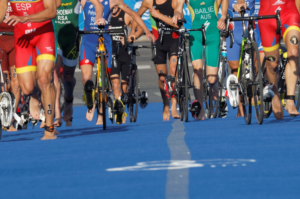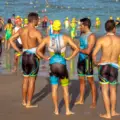Are you curious about what a triathlon is and how it works? If so, you’ve come to the right place. In this comprehensive guide, we will explore the world of triathlons, from the order of events to the reasons behind it. Whether you’re a seasoned triathlete or just starting your journey into the sport, this article will provide you with valuable insights and information. So let’s dive in!
Understanding the Triathlon Format
A triathlon is a multisport event that combines three different disciplines: swimming, cycling, and running. While there are various types of triathlons, the most common format involves completing these three sports consecutively in a specific order. The order of events in a triathlon is always swim, bike, and run.
The Origins of Triathlon
The history of triathlon dates back to the 1920s in France when events combining running, cycling, and canoeing were held. However, the modern triathlon format as we know it today originated in San Diego, California, in 1974. The first triathlon consisted of a run-cycle-swim race, and it quickly gained popularity. The iconic Ironman Triathlon, which includes a 2.4-mile swim, 112-mile bike ride, and 26.2-mile run, was first held in Hawaii in 1978 and played a significant role in popularizing the sport.
The Order of Events: Swim, Bike, Run
The order of events in a triathlon is not arbitrary; it is carefully designed for several reasons. Let’s explore why the swim-bike-run sequence is the standard format for triathlons.
1. Swim Safety
Safety is a top priority in triathlons, and the swim leg is considered the most hazardous in terms of safety. By placing the swim leg first, organizers minimize the risk of exhaustion and potential drowning incidents. Triathlons often attract a wide range of participants with varying swimming abilities, so starting with the swim allows athletes to tackle this challenging discipline when they are fresh and have the most energy.
2. Bike Safety
Bike safety is another crucial consideration in triathlons. Placing the bike leg after the swim minimizes the risk of accidents and collisions. As athletes transition from swimming to cycling, they are typically more alert and focused, reducing the likelihood of crashes. Ending with the bike leg could be risky due to the potential fatigue and decreased concentration levels of participants.
3. Speed and Efficiency
The order of events in a triathlon also aims to optimize speed and efficiency. Starting with the swim allows athletes to complete the most technically challenging discipline first. Additionally, transitioning from swimming to cycling is smoother than transitioning from cycling to swimming or running. Removing a wet wetsuit after a swim is easier and quicker than putting it on, allowing athletes to save valuable time during transitions.
4. Drafting Considerations
Drafting, which refers to closely following another athlete to reduce wind resistance, is a significant factor in triathlon racing. By starting with the swim, triathlons can maintain a fair competition environment. If the bike leg were the first discipline, drafting would be nearly impossible to regulate in non-drafting triathlons like Ironman races. Placing the swim leg first ensures that the race is fair and evenly challenging for all participants.
5. Logistical Considerations
Organizing a triathlon requires careful logistical planning. Starting with the swim leg reduces the need for a large starting area capable of accommodating thousands of athletes on their bicycles. Similarly, ending with the run leg eliminates the need for a wide road and a deceleration area for cyclists sprinting to the finish line. By following the swim-bike-run order, organizers can manage logistics more efficiently, including parking areas, transition zones, and post-race nutrition delivery.
6. Traffic Control
Triathlons often involve some level of traffic control to ensure the safety of participants and minimize disruption to drivers. By placing the bike leg toward the beginning of the event, triathlons can take advantage of early morning hours on festive days when traffic is typically lighter. This arrangement allows for more convenient road closures or minimal disruption to drivers, enhancing the overall race experience for everyone involved.
7. Spectacle and Competition
The order of events in a triathlon also contributes to the spectacle and competitiveness of the sport. By leaving the run leg as the final discipline, triathlons can showcase the dramatic differences in performance between athletes. Strong runners have the opportunity to make up for any gaps created by fast cyclists, creating an exciting race dynamic. This effect is particularly evident in draft-legal triathlons, where athletes can stay in the same group during the bike leg, and the race is often determined by the running stage.
Exploring Different Triathlon Distances
Triathlons come in various distances, catering to athletes of all levels. While the swim-bike-run order remains the same, the distances of each discipline may vary. Here are some common triathlon distances:
- Sprint Triathlon: This entry-level distance typically includes a 0.5-mile swim, 12.4-mile bike ride, and 3.1-mile run. Sprint triathlons are a great starting point for beginners looking to challenge themselves.
- Olympic Triathlon: Also known as the standard distance, an Olympic triathlon consists of a 0.93-mile swim, 24.8-mile bike ride, and 6.2-mile run. This distance is considered a significant step up from the sprint distance and requires more endurance and training.
- 70.3 Triathlon: Commonly referred to as a half Ironman, a 70.3 triathlon involves a 1.2-mile swim, 56-mile bike ride, and 13.1-mile run. This distance provides a taste of the longer, full Ironman experience while being more approachable for many athletes.
- Ironman Triathlon: The ultimate test of endurance, an Ironman triathlon consists of a 2.4-mile swim, 112-mile bike ride, and 26.2-mile run (a full marathon). Completing an Ironman is a remarkable achievement that requires months of dedicated training and mental fortitude.
Triathlons are exciting and challenging multisport events that test the limits of athletes’ physical and mental abilities. The order of events in a triathlon, starting with the swim and followed by the bike and run, is designed with safety, speed, efficiency, logistics, and competition in mind. Understanding the reasons behind this order can help participants and enthusiasts appreciate the thoughtfulness that goes into organizing these incredible events. So, whether you’re considering your first triathlon or are a seasoned triathlete, embrace the swim-bike-run sequence, and enjoy the exhilarating journey that awaits you in the world of triathlon.


